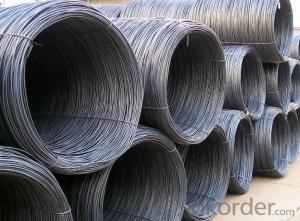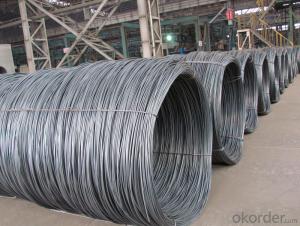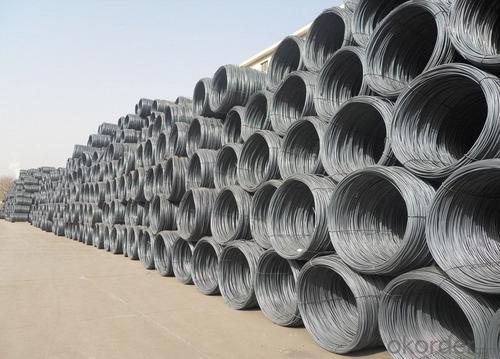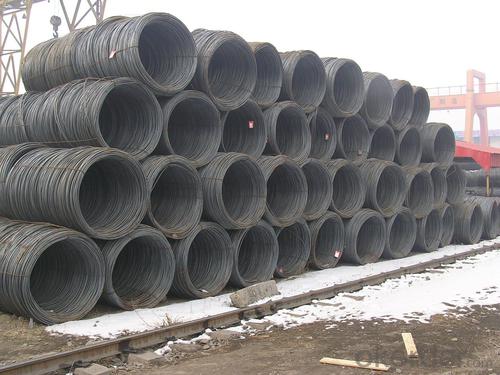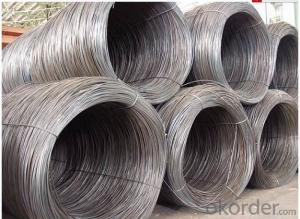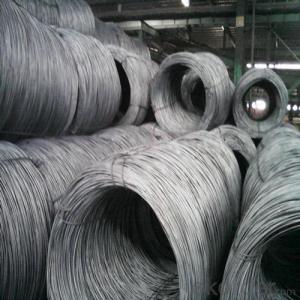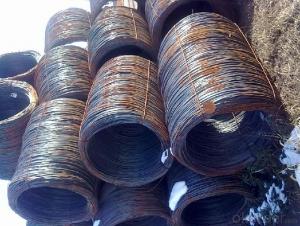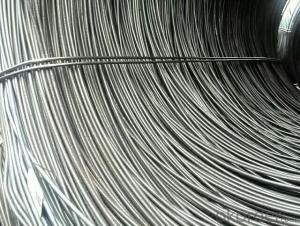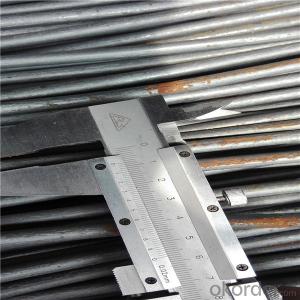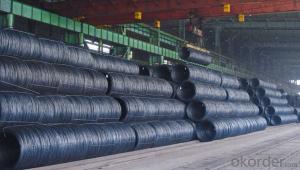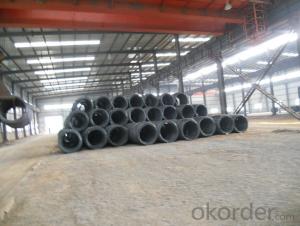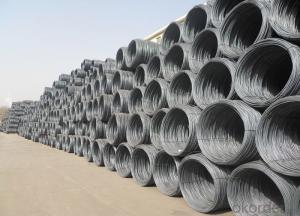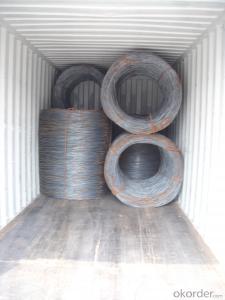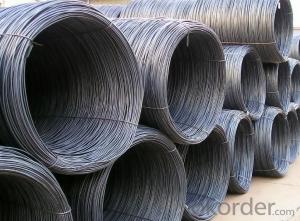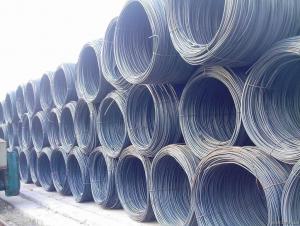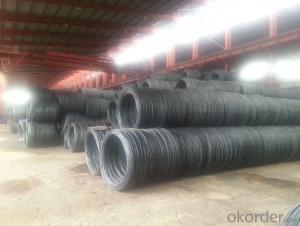Prime Metal Wire Rod in Low Carbon Packed in Coil
- Loading Port:
- China main port
- Payment Terms:
- TT OR LC
- Min Order Qty:
- 100 m.t.
- Supply Capability:
- 10000 m.t./month
OKorder Service Pledge
OKorder Financial Service
You Might Also Like
Specification
Product Description:
OKorder is offering Prime Metal Wire Rod in Low Carbon Packed in Coil at great prices with worldwide shipping. Our supplier is a world-class manufacturer of steel, with our products utilized the world over. OKorder annually supplies products to African, South American and Asian markets. We provide quotations within 24 hours of receiving an inquiry and guarantee competitive prices.
Product Applications:
Prime Metal Wire Rod in Low Carbon Packed in Coil are ideal for structural applications and are widely used in construction and manufacturing. Carbon steel wire rod is mainly used for reinforcement of reinforced concrete and welded structure or reprocessed (roberts , nail, etc.) materials, especially used to produce wire drawing, welding electrode, nails, spring, electronic, precise machinery parts and so on.
Product Advantages:
OKorder's Prime Metal Wire Rod in Low Carbon Packed in Coil are durable, strong, and wide variety of sizes.
Main Product Features:
· Premium quality
· Prompt delivery & seaworthy packing (30 days after receiving deposit)
· Can be recycled and reused
· Mill test certification
· Professional Service
· Competitive pricing
Product Specifications:
Manufacture: Hot rolled
Grade:SAE1006,SAE1008B
Certificates: ISO, SGS, BV, CIQ
Packaging: Export packing, nude packing, in coils, each coil around 2mt
Size: 5.5mm, 6.5mm, 8mm, 10mm
Grade | Chemical Composition(%) | |||||
C | Mn | Si | S | P | B | |
SAE1006B | 0.03~O.07 | ≤0.32 | ≤0.30 | ≤0.045 | ≤0.040 | >0.0008 |
Mechanical properties | ||||||
Yield strength(N/mm2) | Tensile strength(N/mm2) | Elongation(%) | ||||
250-280 | 350-380 | ≥32 | ||||
Grade | Chemical Composition(%) | |||||
C | Mn | Si | S | P | B | |
SAE1008B | 0.10max | 0.3~O.50 | 0.15max | 0.050max | 0.040 max | 0.0008 min |
Mechanical properties | ||||||
Yield strength(N/mm2) | Tensile strength(N/mm2) | Elongation(%) | ||||
FAQ:
Q1: Why buy Materials & Equipment from OKorder.com?
A1: All products offered byOKorder.com are carefully selected from China's most reliable manufacturing enterprises. Through its ISO certifications, OKorder.com adheres to the highest standards and a commitment to supply chain safety and customer satisfaction.
Q2: How do we guarantee the quality of our products?
A2: We have established an advanced quality management system which conducts strict quality tests at every step, from raw materials to the final product. At the same time, we provide extensive follow-up service assurances as required.
Q3: How soon can we receive the product after purchase?
A3: Within three days of placing an order, we will arrange production. The normal sizes with the normal grade can be produced within one month. The specific shipping date is dependent upon international and government factors, the delivery to international main port about 45-60days.
Images:

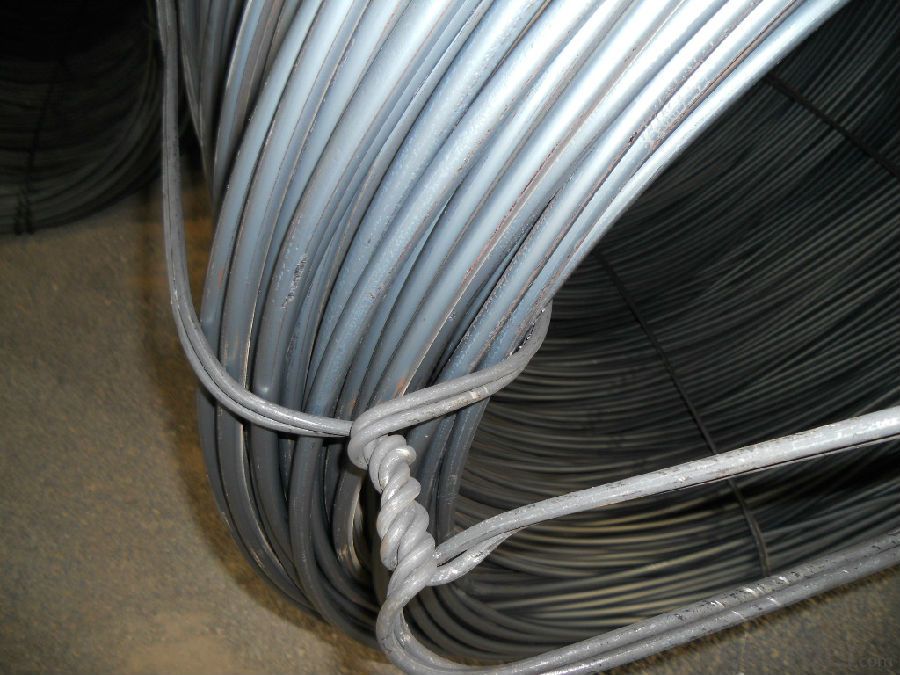
- Q: How is steel wire rod used in the manufacturing of wire mesh cages?
- Steel wire rod is used in the manufacturing of wire mesh cages by being drawn through a series of dies to reduce its diameter and increase its length. This process, called wire drawing, results in a thin and flexible wire that is then woven or welded together to create the mesh structure of the cages. The strength and durability of steel wire make it ideal for constructing wire mesh cages, providing a secure and reliable enclosure for various applications such as animal cages, storage containers, and safety barriers.
- Q: What are the standard tolerances for steel wire rod diameter?
- The standard tolerances for steel wire rod diameter can vary depending on the specific industry and application. However, common tolerances for steel wire rod diameter range between +/- 0.005 inches to +/- 0.010 inches. These tolerances ensure that the wire rods meet the required specifications and can be used effectively in various manufacturing processes.
- Q: How is steel wire rod used in the manufacturing of screws and bolts?
- Screws and bolts cannot be produced without steel wire rod, which is an essential element in their manufacturing process. This wire rod acts as the primary material from which these fasteners are made. To transform the steel wire rod into screws and bolts, a series of manufacturing procedures are carried out. Initially, the steel wire rod is subjected to a high temperature, causing it to soften. This process, known as annealing, increases the wire rod's malleability and makes it easier to handle. Once heated, the wire rod is then passed through a set of dies that shape it into the desired form. These dies are specially designed to create the thread pattern characteristic of screws and bolts. After the wire rod has been shaped, it is cut into appropriate lengths to produce individual screws and bolts. These lengths are further processed to incorporate essential features, such as the head shape and slot or recess for screwdrivers. In certain cases, the wire rod may also undergo treatment with various coatings or finishes to improve its durability and resistance to corrosion. The use of steel wire rod in the manufacturing of screws and bolts offers numerous advantages. Steel is well-known for its strength and durability, making it an ideal material for fasteners that must endure high levels of stress or tension. Additionally, steel wire rod is readily accessible and cost-effective, making it a popular choice for mass production. In conclusion, the significance of steel wire rod in the production of screws and bolts cannot be overstated. It acts as the starting material, which is then shaped and processed to create the final product. The utilization of steel wire rod ensures that screws and bolts possess the necessary strength, durability, and ability to fulfill their intended purpose in various applications.
- Q: How is steel wire rod used in the manufacturing of wire for agricultural fencing?
- Steel wire rod is used in the manufacturing of wire for agricultural fencing by being drawn through a series of dies to reduce its diameter and increase its length. This process, known as wire drawing, results in a strong and durable wire that is then woven or welded into the desired fencing shape. The high tensile strength of steel wire rod ensures that the agricultural fencing can withstand the pressure and stress it may encounter in outdoor environments, making it an ideal material for securing livestock and crops.
- Q: What are the factors to consider when selecting steel wire rod for a specific application?
- When selecting steel wire rod for a specific application, several factors need to be considered. Firstly, the mechanical properties of the wire rod, such as its tensile strength, yield strength, and elongation, should match the requirements of the application. Additionally, the wire rod's chemical composition and microstructure should be suitable for the intended use to ensure optimal performance and durability. Other factors include the surface quality, diameter, and shape of the wire rod, as well as any specific coatings or treatments that may be required. Furthermore, factors like cost, availability, and environmental considerations can also influence the selection process.
- Q: How is steel wire rod stored at the customer's site?
- Steel wire rod is typically stored at the customer's site in a variety of ways depending on the specific requirements and conditions. One common method is to store the steel wire rod on racks or pallets, especially if the customer has a large quantity of rods. These racks or pallets are usually placed in an organized manner to ensure easy accessibility and safety. In addition to racks or pallets, steel wire rod can also be stored in bundles or coils, particularly when the customer requires smaller quantities or wants to maintain the wire rod's shape and integrity. These bundles or coils are often secured with straps or bands to prevent any movement or damage during storage or transportation. Furthermore, the storage area for steel wire rod should be dry, clean, and well-ventilated to prevent corrosion or other forms of damage. Proper protection measures, such as covering the wire rod with tarps or plastic sheets, may be employed to shield it from dust, moisture, or other environmental elements. It is important for customers to follow any specific storage instructions provided by the manufacturer or supplier to ensure the longevity and quality of the steel wire rod. This may include guidelines on temperature control, stacking limitations, or the use of specialized equipment for handling and storage. Overall, the storage of steel wire rod at the customer's site should prioritize safety, accessibility, and protection to guarantee the optimal performance and usability of the product.
- Q: What are the environmental impacts of producing steel wire rod?
- The production of steel wire rod can have various environmental impacts, both during the extraction of raw materials and the manufacturing process. Here are some of the key environmental impacts associated with producing steel wire rod: 1. Resource extraction: Steel wire rod is primarily made from iron ore, which requires extensive mining activities. These mining operations can lead to deforestation, habitat destruction, and soil erosion. Furthermore, the extraction and transportation of iron ore contributes to greenhouse gas emissions and air pollution. 2. Energy consumption: The production of steel wire rod involves several energy-intensive processes, such as smelting, refining, and shaping. These processes typically rely on fossil fuels, such as coal and natural gas, which release large amounts of carbon dioxide into the atmosphere. High energy consumption not only contributes to climate change but also depletes non-renewable resources. 3. Air and water pollution: The manufacturing process for steel wire rod can release various pollutants into the air and water. During smelting, emissions of sulfur dioxide, nitrogen oxides, and particulate matter can contribute to air pollution and acid rain. Water pollution can occur through the discharge of wastewater containing heavy metals, oil, and chemicals used in the production process, potentially contaminating nearby water bodies. 4. Waste generation: Steel wire rod production generates significant amounts of waste materials, including slag, dust, and sludge. These waste products often contain harmful substances, such as heavy metals and toxic chemicals, which can pollute the environment if not properly managed. Waste disposal can also contribute to land degradation and the depletion of natural resources. 5. Carbon emissions: Steel production, including the production of wire rod, is a major contributor to global carbon emissions. The high temperatures required to convert iron ore into steel result in the release of large amounts of carbon dioxide. Additionally, the use of fossil fuels in the manufacturing process further adds to the carbon footprint of steel wire rod production. To mitigate these environmental impacts, the steel industry has been adopting various measures such as implementing cleaner technologies, improving energy efficiency, and reducing reliance on fossil fuels. Additionally, recycling steel scrap can significantly reduce the environmental burden associated with steel wire rod production.
- Q: What are the major opportunities for companies in the steel wire rod market?
- Some major opportunities for companies in the steel wire rod market include expanding into emerging economies with growing construction and infrastructure sectors, diversifying product offerings to cater to various industries such as automotive and aerospace, embracing technological advancements to improve production efficiency and quality, and exploring sustainable practices to meet the growing demand for environmentally friendly steel products.
- Q: How is the formability of steel wire rod assessed?
- Steel wire rod's formability is typically evaluated through a range of mechanical tests and evaluations. The tensile test is a commonly used method, involving the pulling of a wire rod sample until it breaks. This test allows for the determination of the maximum load the wire rod can endure before failure, providing valuable insights into its strength and ductility. Another evaluation method is the bend test, where the wire rod is bent to a specified angle without any cracks or fractures. This test assesses the wire rod's ability to withstand deformation without failure or the occurrence of defects. Furthermore, the deep drawing test is utilized to measure the wire rod's capacity to be stretched and shaped into intricate forms without fracturing or tearing. This test is especially relevant for wire rod used in manufacturing processes like automotive components or household appliances. Additionally, assessments may include hardness testing, which measures the wire rod's resistance to indentation or penetration, and impact testing, which evaluates its ability to absorb energy under sudden loading conditions. By conducting these tests and evaluations, manufacturers and researchers can ascertain the formability of steel wire rod and ensure that it meets the required standards and specifications for specific applications.
- Q: What are the standard hardness requirements for steel wire rod?
- The standard hardness requirements for steel wire rod can vary depending on the specific application and industry standards. However, in general, steel wire rod is commonly required to have a hardness of around 100-300 HB (Brinell hardness) or 10-30 HRC (Rockwell hardness). These hardness requirements ensure the wire rod's strength and durability for various purposes, such as manufacturing springs, cables, and reinforcing materials.
Send your message to us
Prime Metal Wire Rod in Low Carbon Packed in Coil
- Loading Port:
- China main port
- Payment Terms:
- TT OR LC
- Min Order Qty:
- 100 m.t.
- Supply Capability:
- 10000 m.t./month
OKorder Service Pledge
OKorder Financial Service
Similar products
Hot products
Hot Searches
Related keywords
